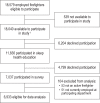Common sleep disorders increase risk of motor vehicle crashes and adverse health outcomes in firefighters
- PMID: 25580602
- PMCID: PMC4346644
- DOI: 10.5664/jcsm.4534
Common sleep disorders increase risk of motor vehicle crashes and adverse health outcomes in firefighters
Abstract
Study objectives: Heart attacks and motor vehicle crashes are the leading causes of death in US firefighters. Given that sleep disorders are an independent risk factor for both of these, we examined the prevalence of common sleep disorders in a national sample of firefighters and their association with adverse health and safety outcomes.
Methods: Firefighters (n = 6,933) from 66 US fire departments were assessed for common sleep disorders using validated screening tools, as available. Firefighters were also surveyed about health and safety, and documentation was collected for reported motor vehicle crashes.
Results: A total of 37.2% of firefighters screened positive for any sleep disorder including obstructive sleep apnea (OSA), 28.4%; insomnia, 6.0%; shift work disorder, 9.1%; and restless legs syndrome, 3.4%. Compared with those who did not screen positive, firefighters who screened positive for a sleep disorder were more likely to report a motor vehicle crash (adjusted odds ratio 2.00, 95% CI 1.29-3.12, p = 0.0021) and were more likely to self-report falling asleep while driving (2.41, 2.06-2.82, p < 0.0001). Firefighters who screened positive for a sleep disorder were more likely to report having cardiovascular disease (2.37, 1.54-3.66, p < 0.0001), diabetes (1.91, 1.31-2.81, p = 0.0009), depression (3.10, 2.49-3.85, p < 0.0001), and anxiety (3.81, 2.87-5.05, p < 0.0001), and to report poorer health status (p < 0.0001) than those who did not screen positive. Adverse health and safety associations persisted when OSA and non-OSA sleep disorders were examined separately.
Conclusions: Sleep disorders are prevalent in firefighters and are associated with increased risk of adverse health and safety outcomes. Future research is needed to assess the efficacy of occupational sleep disorders prevention, screening, and treatment programs in fire departments to reduce these safety and health risks.
Keywords: Occupational health; driving; obstructive sleep apnea; safety.
© 2014 American Academy of Sleep Medicine.
Figures
References
-
- Centers for Disease Control and Prevention. Fatalities among volunteer and career firefighters--United States, 1994-2004. JAMA. 2006;295:2594–6.
-
- World Health Organization. Road Traffic Injuries. Fact Sheet N358. 2013. Mar, http://www.who.int/mediacentre/factsheets/fs358/en/index.html.
-
- Colten HR, Alteveogt BM. Sleep disorders and sleep deprivation: an unmet public health problem. Washington, DC: National Academies Press; 2006. Institute of Medicine (US) Committee on Sleep Medicine and Research. - PubMed
-
- Centers for Disease Control and Prevention (CDC) Drowsy driving - 19 states and the District of Columbia, 2009-2010. MMWR Morb Mortal Wkly Rep. 2013;61:1033–7. - PubMed
-
- Vargas de Barros V, Martins LF, Saitz R, Bastos RR, Ronzani TM. Mental health conditions, individual and job characteristics and sleep disturbances among firefighters. J Health Psychol. 2013;18:350–8. - PubMed
Publication types
MeSH terms
LinkOut - more resources
Full Text Sources
Other Literature Sources
Medical


